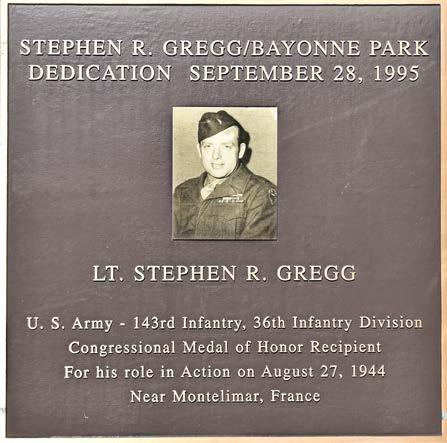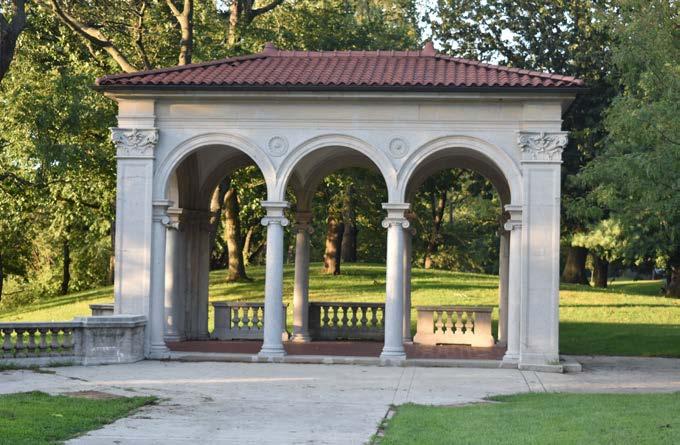
4 minute read
Stephen Gregg Park

Story and photos by Pat Bonner
Advertisement
Imay be biased, but I think Stephen Gregg (Hudson County) Park is the best thing in Bayonne. I grew up in the park in the 1950s and 1960s and it’s still as scenic as it was then. But it’s a lot more popular now, and there’s more to do. Recent additions have improved a venue that’s attracted Bayonne residents for the past 108 years.
There’d been a small park at the site for years, but in 1903, the Hudson County Park Commission decided to create a much larger park. Over the next few years, it negotiated and bought the property of 95 separate owners to create the park that now stretches from 37th to 48th Street. At that time, the area had about 3,000 trees and a long sand beach stretching from below the ridge through the center of the park today. Over the ensuing years, the beach was filled in with soil that was removed when Avenue B was paved. It’s rumored that some of the earth removed during the construction of Rockefeller Center was put in this area.
The Park’s designer was Charles Lowrie, who designed most other large parks in Hudson County. With Hudson County Park, it seems as if he had two parks in mind due to the topography. The upper part was traditional for the early 1900s. The lower part was for athletics and activity. The areas are separated by a ridge that holds two iconic tunnels that provide echoes for kids when they walk through.
Heroes Honored
Originally, the park was called Hudson County Park, but in 1997 it was renamed Tennis Camp Counselors

the Stephen Gregg Park. Lieutenant Gregg won the Congressional Medal of Honor for bravery in France during World War II. A plaque honoring Lt. Gregg on 42nd Street will be replaced in the near future with a statue of his likeness. The park features statues honoring those lost in World War I and the Spanish American War as well as a plaque honoring Doug O’Neill, missing in action during the Vietnam War.
The most distinctive feature of the upper park is the network of walkways through hundreds of older trees, including many London planes or buttonwoods planted in the 1920s. Many lead to the huge, popular playground. The park has 21 fulltime workers to care for the playground and greenery, with additional workers hired seasonally.
The gazebo at the foot of 48th Street, part of the original design, was meant to host small concerts. While picturesque, it’s largely unused today except to hold a Christmas tree during the holidays. Many uptown residents have fond memories of sledding on Double Hill. The area is still used for sledding, and the large number of picnic tables makes it popular in summer.
A Real Winner
Though the ten tennis courts are no longer clay, they’re still crowded even during a pandemic. A tennis camp for
7-13-year-olds is run by the county with six staff members and about 25 campers, down from the usually 40-50 children in non-COVID years.
The best way to access the lower area is down the grand stairway on 40th Street. It’s part of the traditional park as are the two gazebos that flank it. The athletic area starts at the foot of the stairs with basketball courts named for Jeff Farley, a longtime PAL basketball coach. These courts are so popular that the county recently added an additional two courts, closer to Newark Bay.
For me, this area has changed the most. In my day, there would be some kids playing pickup football or Park’s League baseball and maybe a few runners, including Chuck Wepner doing roadwork. Today, the area teems with walkers, joggers, retirees sitting on benches, and people of all ages playing soccer, baseball, softball, and basketball. The park hosts three soccer, four Little League and two men’s baseball leagues as well as a few basketball camps. The county recently spent $3.7 million to install new synthetic turf, LED lighting, and two additional soccer fields. A new workout area is nestled in a stand of London Plane trees with an outstanding view of the container ships at Port Newark.

Like Fine Wine …
Though I miss skating on Killie Pond, I have to admit that the area is now prettier and smells a lot better than it once did. The pond and surrounding area have been refurbished with a new walking path among other improvements. The many turtles living in the pond seem to appreciate the upgrade.
Whether a morning or evening stroll, you can’t beat the half-mile walkway along Newark Bay. You can observe the modern shipping industry across the bay and then see part of Bayonne’s maritime history: the Elco crane in Rutkowski Park. This crane was used in the building of hundreds of PT boats during World War II, including PT109, commanded by future President John F. Kennedy.
Most things don’t get better with age, but I think Hudson County/Stephen Gregg Park has. While maintaining its traditional feel, added features are drawing more people to this gem on the bay.—BLP












